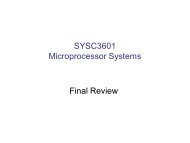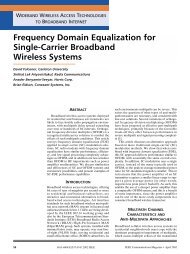Image Reconstruction for 3D Lung Imaging - Department of Systems ...
Image Reconstruction for 3D Lung Imaging - Department of Systems ...
Image Reconstruction for 3D Lung Imaging - Department of Systems ...
You also want an ePaper? Increase the reach of your titles
YUMPU automatically turns print PDFs into web optimized ePapers that Google loves.
4.5.3.2 Nonlinear <strong>Reconstruction</strong>s<br />
We investigated the use <strong>of</strong> the fixed NF method with an iterative static reconstruction<br />
algorithm. In this experiment we used fixed NF to calculate a single hyperparameter that<br />
was used <strong>for</strong> each iteration. Running the algorithm to convergence indicated that the λNF=1<br />
was located in the minimum region <strong>of</strong> the resolution curve. It may be possible to use the<br />
fixed NF method to calculate a new hyperparameter <strong>for</strong> each step <strong>of</strong> the iterative algorithm,<br />
however, this was not pursued.<br />
4.5.3.3 Inverse Crime<br />
The act <strong>of</strong> employing the same model to generate, as well as to invert, simulated data is<br />
known as an inverse crime [122]. In this work, data were simulated using a 1968 element<br />
mesh, so reconstructions using the same mesh constitute an inverse crime. Such reconstructions<br />
had noticeably better resolution than was achieved with other meshes and, as shown<br />
in figures 4.11(a) and 4.11(b), exhibited λBestRes and λLC corresponding to an uncharacteristically<br />
high NF. This suggests a method to detect inverse crimes: using the suspect<br />
FEM, and associated data, construct a resolution curve or L-curve with the simulated data<br />
and calculate the NF corresponding to λBestRes or λLC. If the NF >> 3 (<strong>for</strong> example,<br />
figure 4.11(a) had NF > 7) it is likely that the reconstruction algorithm is committing<br />
an inverse crime. The method was validated by the observation that reconstructions over<br />
the 1968 element mesh using tank data did not exhibit the large NF bias while the high<br />
NF phenomenon was observed every an “inverse crime” configuration was analyzed. One<br />
explanation <strong>for</strong> these results is that the optimal hyperparameter <strong>for</strong> the inverse crime case<br />
is significantly lower than that generally required, since the geometry matching between<br />
<strong>for</strong>ward and inverse solutions is giving a regularizing effect.<br />
log10||Rˆx||<br />
10 −2<br />
10 −3<br />
10 −4<br />
λ=1.0273e-006<br />
NF=7.6022<br />
λBestRes = λLC<br />
λNF=1<br />
λ=13.9147<br />
10<br />
log10||Hˆx − z||<br />
−3<br />
(a) L-Curve, NF = 7.6022 at corner is<br />
excessive and indicates inverse crime<br />
Blur Radius<br />
0.34<br />
0.32<br />
0.3<br />
0.28<br />
0.26<br />
0.24<br />
0.22<br />
0.2<br />
λBestRes = λLC λNF=1<br />
NF=7.6022<br />
10 −6 10 −4 10 −2 10 0 10 2<br />
log10(λ)<br />
(b) Resolution curve, NF = 7.6022<br />
is excessive and indicates an inverse<br />
crime.<br />
Figure 4.11: Either the L-curve or resolution curve can be used to detect an inverse crime.<br />
4.6 Conclusion<br />
This paper proposes a new method <strong>of</strong> objective hyperparameter selection <strong>for</strong> use in onestep<br />
image reconstructions and compares it to some existing methods including heuristic<br />
selection. We present the following observations:<br />
59





